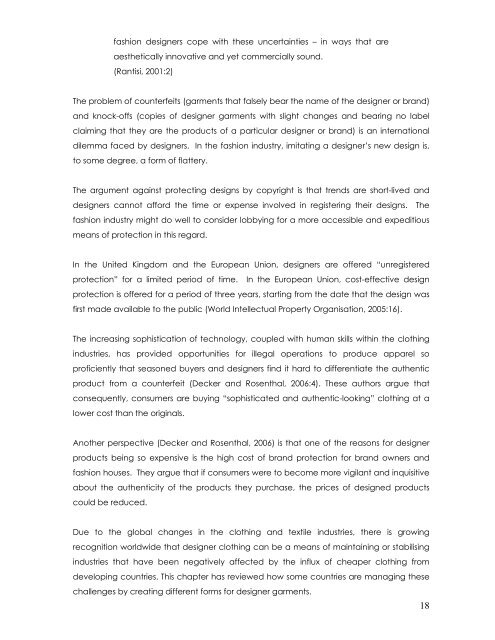Create successful ePaper yourself
Turn your PDF publications into a flip-book with our unique Google optimized e-Paper software.
fashion designers cope with these uncertainties – in ways that are<br />
aesthetically innovative and yet commercially sound.<br />
(Rantisi, 2001:2)<br />
The problem of counterfeits (garments that falsely bear the name of the designer or brand)<br />
and knock-offs (copies of designer garments with slight changes and bearing no label<br />
claiming that they are the products of a particular designer or brand) is an international<br />
dilemma faced by designers. In the fashion industry, imitating a designer’s new design is,<br />
to some degree, a form of flattery.<br />
The argument against protecting designs by copyright is that trends are short-lived and<br />
designers cannot afford the time or expense involved in registering their designs. The<br />
fashion industry might do well to consider lobbying for a more accessible and expeditious<br />
means of protection in this regard.<br />
In the United Kingdom and the European Union, designers are offered “unregistered<br />
protection” for a limited period of time. In the European Union, cost-effective design<br />
protection is offered for a period of three years, starting from the date that the design was<br />
first made available to the public (World Intellectual Property Organisation, 2005:16).<br />
The increasing sophistication of technology, coupled with human skills within the clothing<br />
industries, has provided opportunities for illegal operations to produce apparel so<br />
proficiently that seasoned buyers and designers find it hard to differentiate the authentic<br />
product from a counterfeit (Decker and Rosenthal, 2006:4). These authors argue that<br />
consequently, consumers are buying “sophisticated and authentic-looking” clothing at a<br />
lower cost than the originals.<br />
Another perspective (Decker and Rosenthal, 2006) is that one of the reasons for designer<br />
products being so expensive is the high cost of brand protection for brand owners and<br />
fashion houses. They argue that if consumers were to become more vigilant and inquisitive<br />
about the authenticity of the products they purchase, the prices of designed products<br />
could be reduced.<br />
Due to the global changes in the clothing and textile industries, there is growing<br />
recognition worldwide that designer clothing can be a means of maintaining or stabilising<br />
industries that have been negatively affected by the influx of cheaper clothing from<br />
developing countries. This chapter has reviewed how some countries are managing these<br />
challenges by creating different forms for designer garments.<br />
18
















